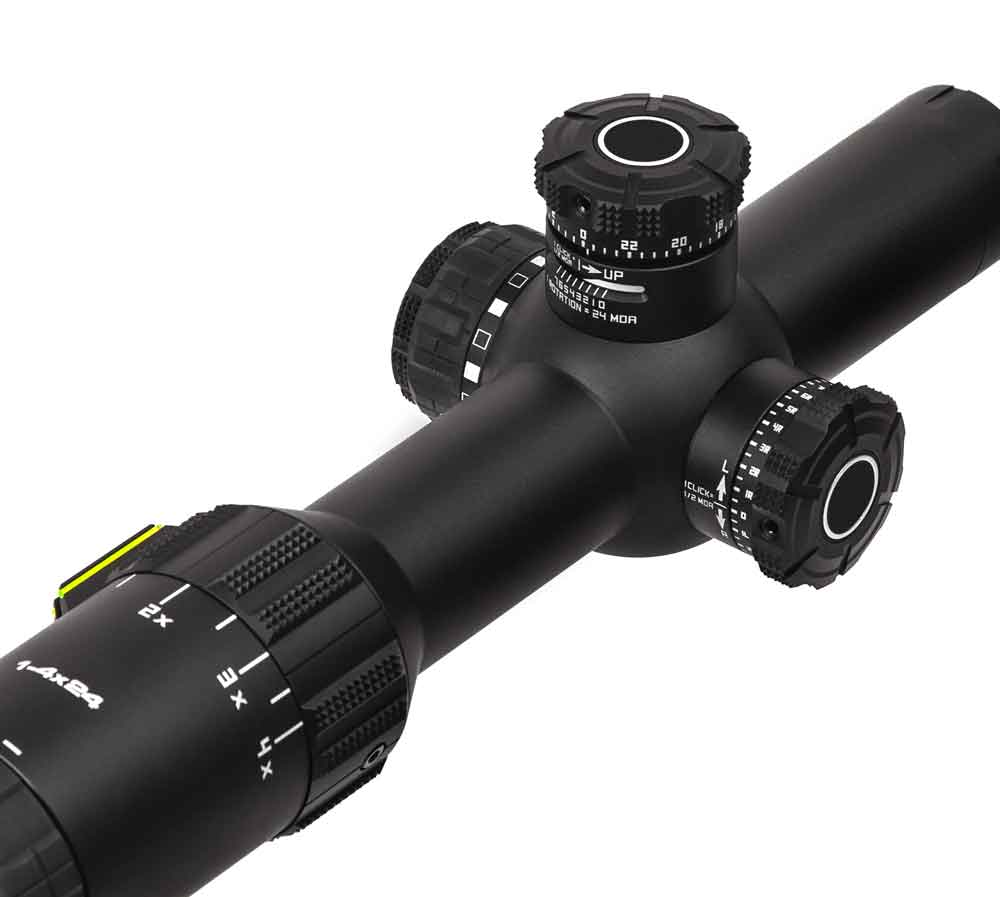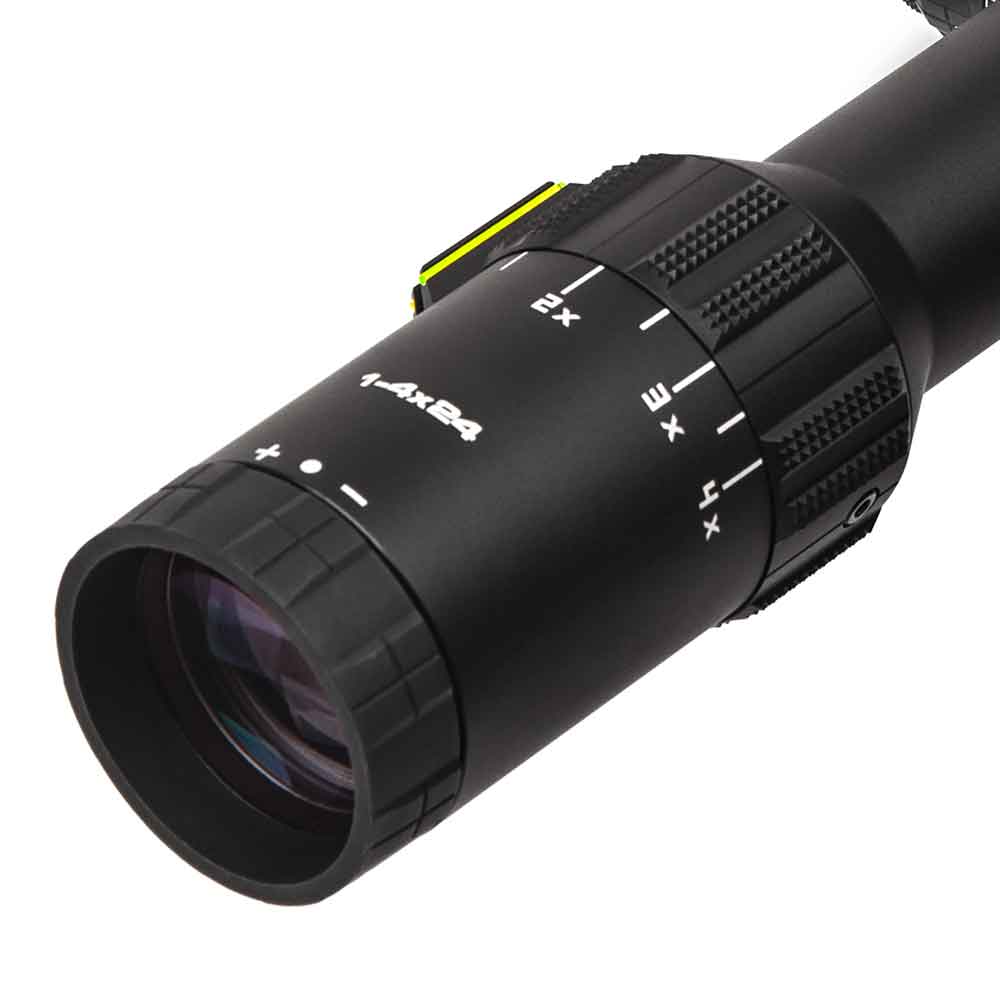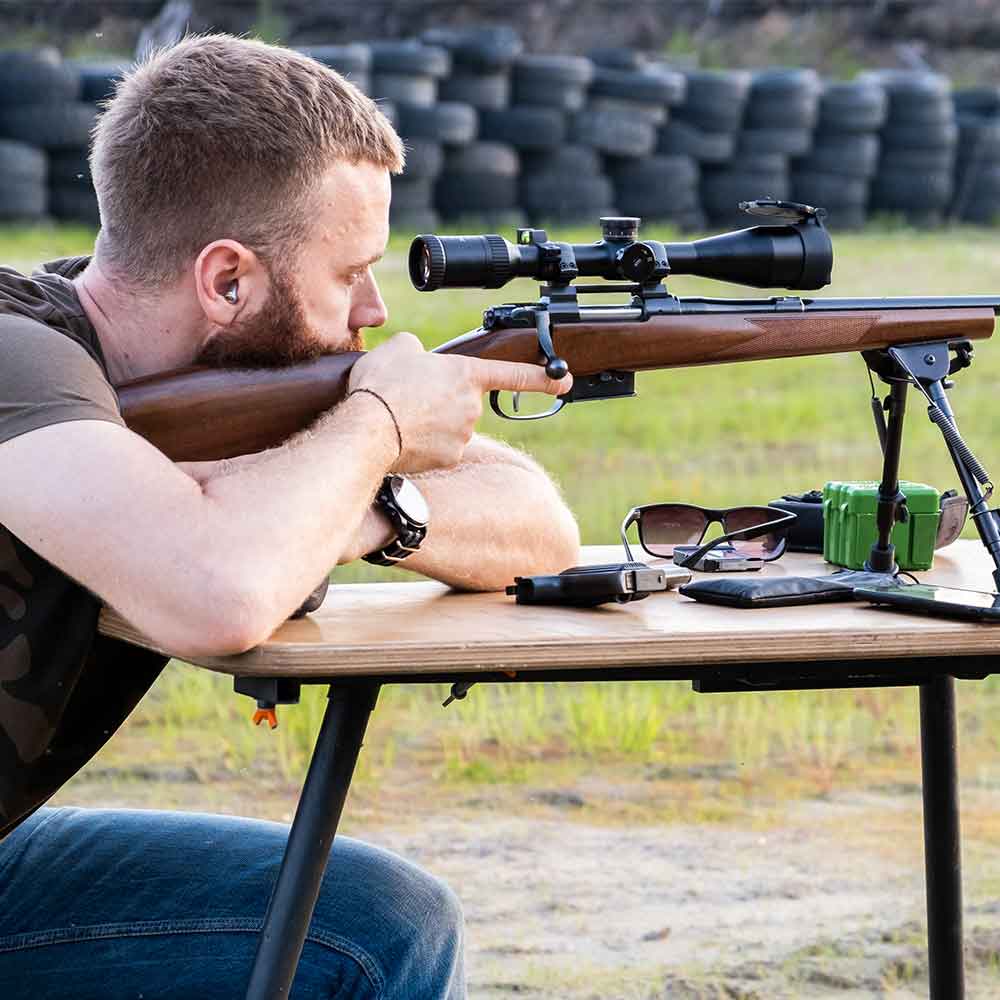
What Do the Numbers on a Rifle or Crossbow Scope Mean?
If you want to skip this entire in-depth breakdown on the meaning of scope numbers, here’s the TL:DR – The first number in an optic’s name describes it’s magnification and the second references it’s size.
A scope is an essential tool for anyone who plans to do any kind of shooting. At its most basic level, it allows you to see distant targets more clearly, making it easier to aim and shoot. In addition, scopes come with various features and settings that can help optimize your shooting experience.
One crucial aspect is the scope number, which indicates the magnification range as well as how much power increases the scope’s focal point. Generally speaking, higher numbers indicate a larger magnification range and increased focus, while lower numbers indicate a greater field of view and easier focusing.
So if you are looking to easily track moving targets or zero in on far off objects, a scope with a high number will be your best option.
How To Read Scope Numbers
Scopes are an essential tool for any marksman. They help improve accuracy by magnifying the target and making it easier to hit. However, understanding how their numbers work can be confusing for some people.
Here is a quick guide to help you understand scope numbers.
The first number on a scope represents the magnification power. This is the amount that the target will be magnified when viewed through the lens.
The second number is the objective lens’s diameter, which is recorded in millimeters.. This number dictates the amount of light that can enter the rifle or crossbow scope and therefore affects how clear the image will be.
The third number is the range, or distance, at which the scope can be used effectively.
Finally, the last number indicates the amount of adjustment that can be made to account for windage and elevation. This number is measured in minutes of angle (MOA).
By understanding these numbers, you can make sure that you’ll choose the proper scope for your needs. And with this knowledge, you’ll be able to shoot with greater precision and accuracy.
When looking at rifle scopes, you may notice a series of numbers along the outside edges of the lenses. These numbers indicate essential aspects such as the fixed power range, variable eye relief, objective lens diameter, and magnification capabilities of your rifle.
For example, a rifle with a fixed power range of 4-12x might give you an increased field of view at low power levels and higher zoom at higher power levels.
These numbers can help you maximize your rifle performance and get the most out of every shot when used wisely!
Scope Nomenclature
There are two types of scope nomenclature: fixed power and variable power. Fixed power scopes have a set magnification, while variable power scopes allow the user to adjust the level of magnification. The numbers on a rifle scope represent the amount of magnification. The first number is the level of magnification at the lowest, and the second is the level of magnification at the highest.
Magnification

A higher magnification corresponds to a more effective tube diameter, with more light passing through the optical surfaces and more detailed or enlarged images. However, magnification has limitations, such as variations in eye position or image stability over longer distances.
Objective
A rifle scope is a handheld optical device used to look at distant objects. The most important part of a rifle scope is the Objective, the lens at the front of the scope that gathers light. The size of the Objective determines how much light the scope can gather, therefore, how bright the image will be. The larger the Objective, the brighter the image, and the heavier the scope. A larger Objective is better for low-light conditions, while a smaller Objective is better for daytime use. Rifle scopes also have a Reticle, a crosshair, or a dot to line up the shot. The type of Reticle you choose should be based on your personal preference and shooting style. There are many different rifle scopes on the market, so it is essential to research the best one for your needs. With so many options available, there is sure to be a crossbow scope perfect for you.
Field of View
The field of view is the diameter of the area that can be seen through the eyepiece. A larger field of view means that more of the night sky can be seen at once, making it easier to find objects of interest. However, a larger field of view also comes with some tradeoffs. Such a large scope means that the exit pupil–the beams of light exiting the eyepiece–will be smaller.
Eye Relief
Scope eye relief is the distance between your eye and the eyepiece lens where you can still see the entire field of view. This is important for two reasons.
First, if your eye is too close to the eyepiece, you will only see part of the image, making it difficult to aim accurately.

Second, when using a high-powered scope, you need to ensure that your eye is far enough away from the lens to avoid being hit by the exit pupil. This small circle of light is created when light passes through the eyepiece lens. It is very bright and can cause severe eye damage if you are not careful.
For this reason, it is always best to use a rifle or crossbow scope with a longer eye relief when hunting or shooting at long range.
Exit Pupil
The exit pupil is the diameter of the light beam that emerges from the eyepiece of a rifle scope. It is usually expressed in millimeters. The size of the exit pupil is determined by the objective lens and the eyepiece.
For example, a scope with a 50mm objective lens and a 10x eyepiece will have an exit pupil of 5mm. The human eye can only dilate to about 7mm, so an exit pupil larger than this will not increase brightness.
In fact, it can be detrimental, as a large exit pupil will cause the eye to move around inside the scope, making it challenging to keep the crosshairs on the target. Therefore, it is important to consider both the objective lens and the eyepiece when choosing a scope to ensure that the exit pupil is neither too large nor too small.
Tube diameter
The tube diameter of a rifle scope refers to the diameter of the main optical body of the scope. This critical aspect of a scope can affect its functions in several essential ways. The tube diameter determines how much light passes through the lens and into your eye. A larger diameter will allow more light to enter, granting superior clarity and visibility even in low-light conditions. Additionally, a large tube diameter allows for more adjustments on a rifle scope, such as windage and elevation adjustments. Finally, the size of the tube can also impact the overall weight and balance of a rifle, making this an essential factor to consider when choosing a scope. Although you choose to measure it, tube diameter is crucial when selecting a new rifle scope.
Length
A critical feature of any scope is its length. The length of scope refers to the distance between one edge and the opposite edge of the lens system. In general, longer scopes have greater magnification capabilities and larger exit pupils, while shorter scopes have higher eye reliefs and a tighter field of view. This makes sense when considering the physics of light: shorter lenses can bend incoming light more sharply than longer lenses, which leads to higher magnification but less distance between your eye and the eyepiece.
Overall, the scope length is an important consideration when deciding which scope is best suited for your needs. Whether you are looking for a simple handheld magnifying glass or a high-power telescope that lets you observe
Weight
Scope weight measures how heavy a telescope or other optical device is. Several different factors can contribute to scope weight, such as the size and type of lenses used, the material from which it is made, and the magnification power of the device. This factor can affect the overall usability and portability of scope, as heavier devices may be more cumbersome for users to carry and use. Specific features such as an exit pupil or eye relief may also impact scope weight. Overall, understanding the tradeoffs between these various factors can help users choose a scope that meets their needs in terms of both function and portability.
Elevation and Windage Adjustment

Scope adjustment is a crucial concept in modern firearm shooting. It refers to the ability of the shooter to adjust the elevation (as well as windage) of the weapon based on factors such as moa, mrad, small exit pupil, longer ranges, nine power magnification, low light conditions, or focal length.
Different scope adjustments may be used depending on the specific application and shooter preferences.
MOA and MRAD
MOA and MRAD are two measurement systems used to describe adjustments in rifle scopes. MOA refers to a method of measurement commonly used by shooters, while MRAD is more commonly used by military and professional snipers. Both systems use the same basic principles, including 360 degrees in a circle and 12 inches per foot, to determine length and distance measurements. However, slightly different calculations are used depending on whether you use MOA or MRAD. For example, to convert MOA to MRAD, you would divide the number of MOAs by 100. Conversely, to convert MRAD back into MOAs, you would multiply the number of MRADs by 3.5. Therefore, while both systems are helpful for accurately measuring distances when shooting with a rifle scope, it is vital to understand which system you are using so that your measurements will be accurate and precise.
Yardage Magnification Examples
Yardage magnification is a term used to describe the ability of a rifle scope to provide a clear, detailed image at different yardage ranges. In other words, it tells how well the scope can zoom in and out, allowing users to estimate both short and long distances with accuracy. This will enable shooters to better aim at their targets, increasing their chances of hitting their mark. A quality yardage magnification system will typically be combined with other features like multiple reticle options, parallax adjustments, and weatherproof sealing, making it an essential component of any good rifle scope
500 yards and 1000 yards
Choosing a rifle scope with the appropriate yardage magnification will help ensure that you are ready for your next hunting expedition! At 500 yards, higher yardage magnifications will allow you to clearly see your target and make precise shots. Conversely, at 1000 yards, lower yardage magnifications will provide a clearer image of the surrounding terrain, helping you avoid potential hazards or obstacles in your path.
What Do These Scope Numbers Mean?
4×32
4×32 is a type of scope, or optical sighting device, commonly found on high-powered rifles. This particular scope is distinguished by its magnification level, which allows the user to see 4 times closer than if they were using normal naked eyesight. It also features crosshairs with a width of 32mm, allowing for easier target acquisition and centered alignment. The 4×32 is considered a versatile and reliable optical sighting device, able to produce clear images even in low light conditions and with minimal distortion around edges. This makes it a popular choice for precision shooting and hunting applications and tactical or military use. Overall, this unique set of features makes 4×32 one of the most popular types of rifle scopes available today.
6-24×50
6-24x means that the scope has a variable scope zoom of 6-24 times, while 50 indicates that the objective lens is 50mm in diameter. This particular scope is often used for long-range shooting, as the high zoom and sizeable objective lens provide clear images at great distances. 6-24×50 scopes are also relatively common, making them easy to find and purchase. However, they can be expensive, so it is essential to do your research before buying. A 6-24×50 scope can last for many years with proper care and maintenance.
2-7×32
2-7×32 is a popular configuration for scopes, and for a good reason. It provides a decent amount of magnification while still keeping the scope relatively compact. This makes it an excellent choice for both hunting and target shooting.
2-7×32 also happens to be an extremely versatile configuration. At the lower end of the magnification range, it can be used for close-up shots, while at the higher end, it can be used for longer-range shots. This makes it ideal for just about any situation. So, if you’re looking for a scope that can do it all, 2-7×32 is a great option to consider.
5x
5x magnification on a rifle scope means that the object will appear 5 times larger than without the scope. This can be helpful in many situations, such as when trying to hit a small target at a long distance. 5x is not the highest level of magnification available on most scopes, but it is a good middle-of-the-road option that can be used in many situations.
20 – 60 x 80mm
20 – 60 x 80mm is a common measurement for the magnification range on a scope. This refers to the level of power that the scope can provide, with 20x being the lowest and 60x being the highest. For example, it might be better to use 20x when shooting at smaller targets or in low-light conditions while opting for higher magnification levels in brighter settings or if you plan to shoot at greater distances.
3-9×40
The first number, 3, refers to the magnification power of the scope. This means that an object will appear three times larger than it would without the scope when looking through the scope. The second number, 9, is the maximum magnification power of the scope. When the magnification is set to 9, the object will appear nine times larger than without the scope. The final number, 40, refers to the size of the objective lens, which is measured in millimeters. This determines how much light can enter the scope and how bright the image will appear. Generally speaking, a larger objective lens will result in a brighter image. Therefore, a 3-9×40 scope has a minimum magnification power of 3 and a maximum magnification power of 9, with an objective lens size of 40 millimeters.
Additionally, rifle scope magnification adjustable eye relief is ideal for shooters who wear protective eyewear or have wide variations in their interpupillary distance. Finally, if you’re looking to boost your rifle’s accuracy and precision, consider choosing a rifle scope with a larger lens diameter.
Conclusion
And at the end of the day, when it comes to investing in quality hunting gear, no other scope matches up when choosing a rifle or crossbow scope; there are many different factors to consider. For example, fixed power scopes typically use a fixed magnification, which means that the zoom level does not change regardless of distance. In contrast, variable power rifle scopes offer a range of variable magnification levels that can adjust depending on the distance between the shooter and their target.
Additionally, it is crucial to consider the size and weight of a crossbow scope, as these can affect its overall usability and effectiveness. Ultimately, choosing a scope that best suits your shooting needs and preferences is essential to achieving optimal accuracy and precision when aiming at your target—the reliability and performance of a mid-range rifle scope. So if you’re serious about getting out there and taking down your big game, make sure that a mid-range rifle scope is part of your gear arsenal.
